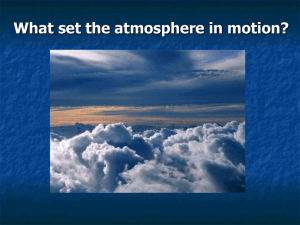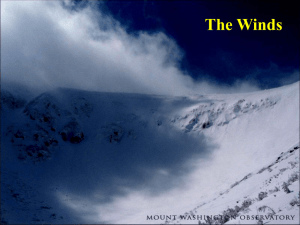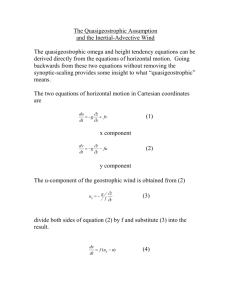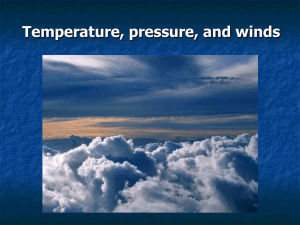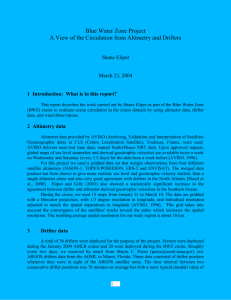Lab 6 - United States Naval Academy
advertisement
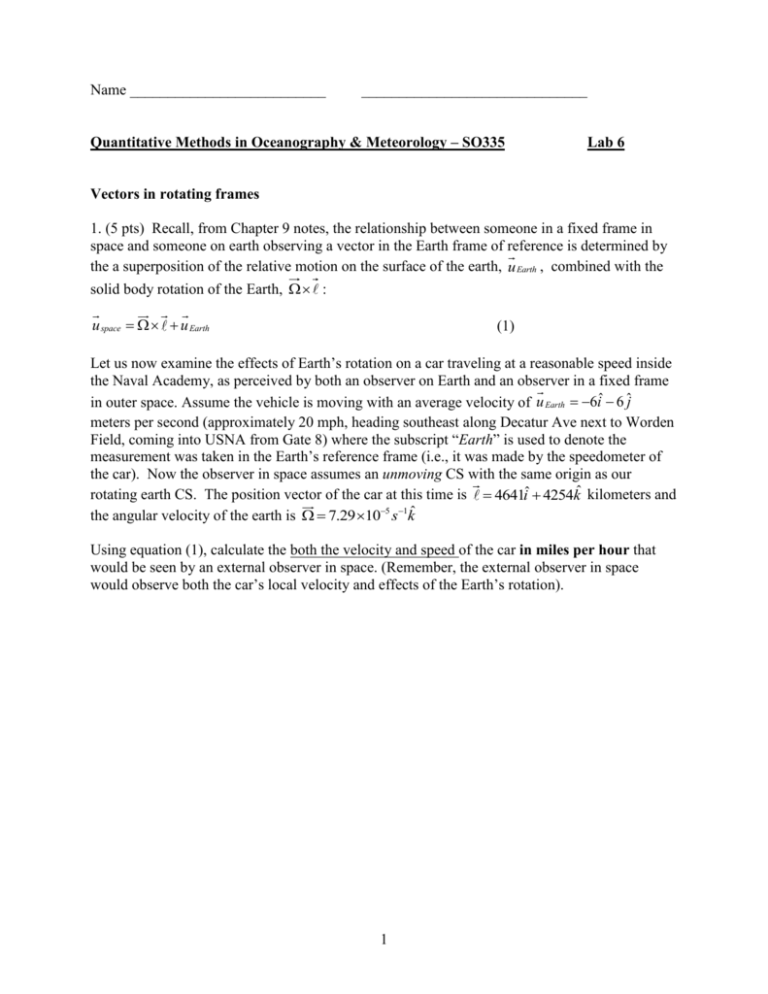
Name __________________________ ______________________________ Quantitative Methods in Oceanography & Meteorology – SO335 Lab 6 Vectors in rotating frames 1. (5 pts) Recall, from Chapter 9 notes, the relationship between someone in a fixed frame in space and someone on earth observing a vector in the Earth frame of reference is determined by the a superposition of the relative motion on the surface of the earth, u Earth , combined with the solid body rotation of the Earth, : u space u Earth (1) Let us now examine the effects of Earth’s rotation on a car traveling at a reasonable speed inside the Naval Academy, as perceived by both an observer on Earth and an observer in a fixed frame in outer space. Assume the vehicle is moving with an average velocity of u Earth 6iˆ 6 ˆj meters per second (approximately 20 mph, heading southeast along Decatur Ave next to Worden Field, coming into USNA from Gate 8) where the subscript “Earth” is used to denote the measurement was taken in the Earth’s reference frame (i.e., it was made by the speedometer of the car). Now the observer in space assumes an unmoving CS with the same origin as our rotating earth CS. The position vector of the car at this time is 4641iˆ 4254kˆ kilometers and the angular velocity of the earth is 7.29 105 s1kˆ Using equation (1), calculate the both the velocity and speed of the car in miles per hour that would be seen by an external observer in space. (Remember, the external observer in space would observe both the car’s local velocity and effects of the Earth’s rotation). 1 Geostrophic flow in f-Plane coordinate system 2. Since it is impractical to consider a CS centered on the earth, we instead need to assume a local Cartesian CS that is centered on the surface of the earth at a specific latitude. This type of CS is normally called the f-plane CS and is represented in Figure 1 at the latitude with the y’ axis pointed north, the x’ axis pointed eastward and the z’ axis pointed upward or vertically. It is called an f-place CS due to the fact that the Coriolis parameter, usually denoted with the letter f, is constant over the entire plane for a given latitude. z z y' y z' Figure 1 – Diagram showing the f-plane CS. a. (5 pts) Given Figure 1, find the projections of Earth’s angular velocity vector onto the y and z axes: y and z . Be sure to find them both in terms of the latitude of the fluid parcel, , and the magnitude of the earth’s rotation . b. (5 pts) Notice that your result above shows that the components of the Coriolis vector vary with latitude. Given that 7.29 105 s 1 , find numerical values for z and y in units of s-1 at a latitude of 38o north (the latitude of Annapolis). 2 Geostrophic flow 3. At the end of the chapter on apparent forces, we derived the acceleration of an object as perceived by an observer in a rotating frame. We then relate this acceleration to forces applied on a given parcel by the use of Newton’s second law The resulting equation was: Du Earth F 2 xh 2 u Earth Dt Some of the forces that will impact the acceleration of the fluid parcel are the pressure gradient force, gravity, and friction. Considering these forces, we arrive at the equation of motion in a rotating frame (neglecting the subscripts for relative motion): Du 1 2 u 2 l h p g F friction Dt o Now let us consider the geostrophic case where we assume a steady state flow and neglect friction, nonlinear effects and centripetal acceleration. For the geostrophic case, we assume a hydrostatic balance in the vertical direction so the governing equation of motion lies entirely in the horizontal f-plane with the form: a) (5 pts) Show how the Navier-Stokes equation of motion reduces to its geostrophic form 1 2 u p for a steady state flow with friction, nonlinear effects, and centripetal o acceleration neglected. Show all work. 3 If we assume rectangular coordinates in the f-plane CS then u uiˆ vjˆ and p p ^ p ^ i j. x y We will also represent the Coriolis vector in the f -plane as z kˆ , in accordance with your calculations in Question 2b. b) (10 pts) Using the geostrophic vector equation, write the component equations for the northerly (v) and easterly wind flow (u) in terms of the easterly and northerly pressure gradients, density ( o ) and the component of the Coriolis vector c) (10 pts) We wish to examine an idealized pressure system represented as the following pressure field x2 y 2 2 o x, y 2 o p 990 10exp 0.5 2 0 Where pressure is in units of millibars and x and y are in units of kilometers. o is a length scale for the pressure field and has the constant value of 250 kilometers. Assuming we are at a latitude kg 38o and that the local density of the atmosphere is o 1.2 3 , we will now use MATLAB m to graph the flow field in the f-plane CS as follows. i. Input the pressure field over the domain 2 o x 2 o , 2 o y 2 o ; o 250km with increments of x y 50 km. ii) Create a graph of a contour of the isobars (label the contours) and then add the hold on command since we are about to overlay additional graphs on this figure. p p iii). Use the gradient function in MATLAB to define the pressure gradient components , x y iv). Using the pressure gradient components defined in step (iii), now define (in MATLAB) the flow field components u and v from the equations you derived in step (3a). v). Use quiver to make a graph of the vector flow field defined in step (iv), superimposed over the pressure isobars contoured in step (ii). 4 Print out the resulting graph, labeling the axes and giving an appropriate title. vi). Trace a couple apparent streamlines of the flow field on the graph you printed out. vii). What do you notice about the flow, with respect to the isobars? Where is the fastest flow located? Why does the flow decrease at the edge of the figure? 4. Real-world geostrophic flow Instead of an idealized pressure field, we can also calculate the geostrophic wind from real-world pressures. Remember, geostrophic flow is the flow that would be observed if the atmosphere and ocean were steady and frictionless. If real-world winds are not geostrophic, it is because other forces act on them besides pressure gradient force and Coriolis force. From the course web site, download the sea level pressure data for 30 October 2014: slp.mat. This mat-file contains three variables sea_level_pressure (73x144), lon (1x144), and lat (1x73). Also download the coastline.mat file. In question 3(b) above, you derived the u and v velocity components for geostrophic flow. Note that geostrophic flow depends on both Coriolis and pressure gradient. You will need to calculate both of those in MATLAB. It might help to first write out the equations below. Remember, in calculating gradient, you must specify the x and y spacing. Both lat and lon are spaced 2.5° apart. But recall, there are approximately 111 km (or 111,000 m) in a degree. Finally, note that the latitudes decrease by 2.5 degrees. Once you calculate the pressure gradient and Coriolis forces at each grid cell, use them to calculate u and v wind components. Use the equations in question 3(b) above, and use 1.2 kg m-3 for density. Note that in each equation, Coriolis is located on the denominator. However, at the equator, Coriolis is zero. This will cause u and v winds to “blow up” to infinity. We need a loop to eliminate those large values. In MATLAB, the “not a number”, or NaN, syntax is a good choice. Input the following loop into your code. Your u and v variable names may be different. %Note that, at the equator, u and v "blow up" because sin(0)=0. Fix it by using a loop for i=1:size(u,1) for j=1:size(u,2) if u(i,j)>300 || u(i,j)<-300 %replace really big u and v with NaN u(i,j)=NaN; end if v(i,j)>300 || v(i,j)<-300 v(i,j)=NaN; end end end 5 Create two figures (10 points each). For the first, contour sea level pressure (convert to millibars for contouring) and overlay the quivered geostrophic wind field in black. If you scale the quivered vectors by 5, they are more visible. Overlay coastlines, insert a colorbar, label the x and y axes, and put an appropriate title. For the second figure, reproduce the first, but then add the u and v wind components from NOAA (download them at u_v_wind_NOAA.mat). Quiver the NOAA winds in blue, and do not scale their arrow lengths. (10 pts each) Print both figures in color and turn in with the lab. (15 points) In the space below, write two paragraphs about the agreement and disagreement between your geostrophic winds and NOAA’s surface wind field. Follow the guidance given in previous labs on good writing practices. 6 4. Tropical model – A geostrophic flow is a good approximation to model some of the large scale features in the atmosphere. Recall that one of the main results of the geostrophic wind is that it is steady-state and parallel to the associated isobars driving the wind. As you can see from your graph in section 3, the idealized isobars of a low pressure system have significant curvature associated with it so the fluid parcels in the above example are constantly changing direction while following the closed isobars of the system. We know from classical physics that a change of direction is an acceleration and thus the system must have a net force as per Newton’s second law. Just like a car racing around an oval track, the fluid parcels will feel a force due to this continual change in direction. Equations (2) do not account for this acceleration effect so the results we obtained in section 3 are suspect. In this section, we will account for Coriolis and pressure forces as before but also take into account the effects of curvature by including a centripetal acceleration term. To examine this additional contribution, let us consider a new physical example where the effects of curvature are prominent; a mature hurricane. It has been empirically1 shown that a mature steady state hurricane’s pressure field can be approximated by RB pr p e p o exp 0B r po 0.1Ro r 10R o ;1.0 B 2.5 (3) Where B is a dimensionless parameter, r represents the radial distance from the center of the hurricane in units of kilometers. R o represents the distance from the center where maximum winds occur (i.e., R o is how far from the center the eye wall is located). For our example we will assume B=1.5 and R o 30km . p e is the sea level pressure in the undisturbed environment which we will assume to be 1010 mb. p o is the sea level pressure at the center of the storm which we will assume to be po 950mb . To derive the associated wind flow pattern from the pressure field in equation (3), we will approximate that the friction boundary layer is near the surface and thus disregard any friction effects in the equations of motion. We will also assume that the vertical flow field is significantly smaller then the horizontal so we can assume hydrostatic balance. The resulting horizontal equation of motion is Du h 2 u Dt h 1 o h p (4) As shown in lectures, the polar coordinate form of equation (4) is 1 Holland, G. J. 1980: An analytic model of the wind and pressure profiles in hurricanes. Mon Wea. Rev., 108, 121212-18 7 u u r u u r u 1 p ur r 2 z u t r r r o r 2 (4a) u u u u uu 1 p u r r 2 z u r t r r r o r Now let us make an additional set of observations and assumptions: I. Assume circular symmetry (axi-symmetry) so: 0 another consequence is that there is no radial component to the flow so ur 0 0. II. The flow is in steady state: t III. The flow is strictly tangential so that there is no radial component to the flow: ur 0 Under these assumptions, the equations from (3a) reduce to 2 u 1 dp 2 z u r o dr (5) By converting to polar coordinates, the two Cartesian component equations of (2) have been reduced to one equation and we now have the effects of curvature included. The axial symmetric flow of equation (5) is called the gradient wind. a. (5 pts) Solve equation (5) for u in terms of z , quadratic equation with respect to u ) 8 dp , r and o (Note that equation 5 is a dr b. (5 pts) Using equation (3), derive the analytic expression for (Hint: using the chain rule will be helpful) r dp ? o dr 9 r dp kg given that o 1.0 3 . o dr m c. (5 pts) Recall the empirical relationship for pressure versus radial distance in equation (3) is given in units of millibars with radial distance expressed in kilometers. But, note that the kg Coriolis vector is usually given with units of s 1 and density has units of 3 . Perform m r dp dimensional analysis to find an appropriate scaling factor for to ensure it has units of o dr r dp km 2 km 2 . (I.e., what do you need to multiply by to make its units ?) Show all work. o dr s2 s2 d. (5 pts) Given your results from parts (a) through (c). Use MATLAB to plot the azimuthal wind speed, u , as a function of radial distance from the eye of the hurricane. Use the positive root to ensure a cyclonic flow and assume z 3 10 5 s 1 . Be sure to use the scaling factor from part (c) when inputting your expressions in MATLAB. Print out the resulting graph after appropriate labels have been added. e) (5 pts) What is the maximum azimuthal wind speed of this hypothetical hurricane in units of knots? At what radial distance in kilometers do these maximum winds occur? 10
